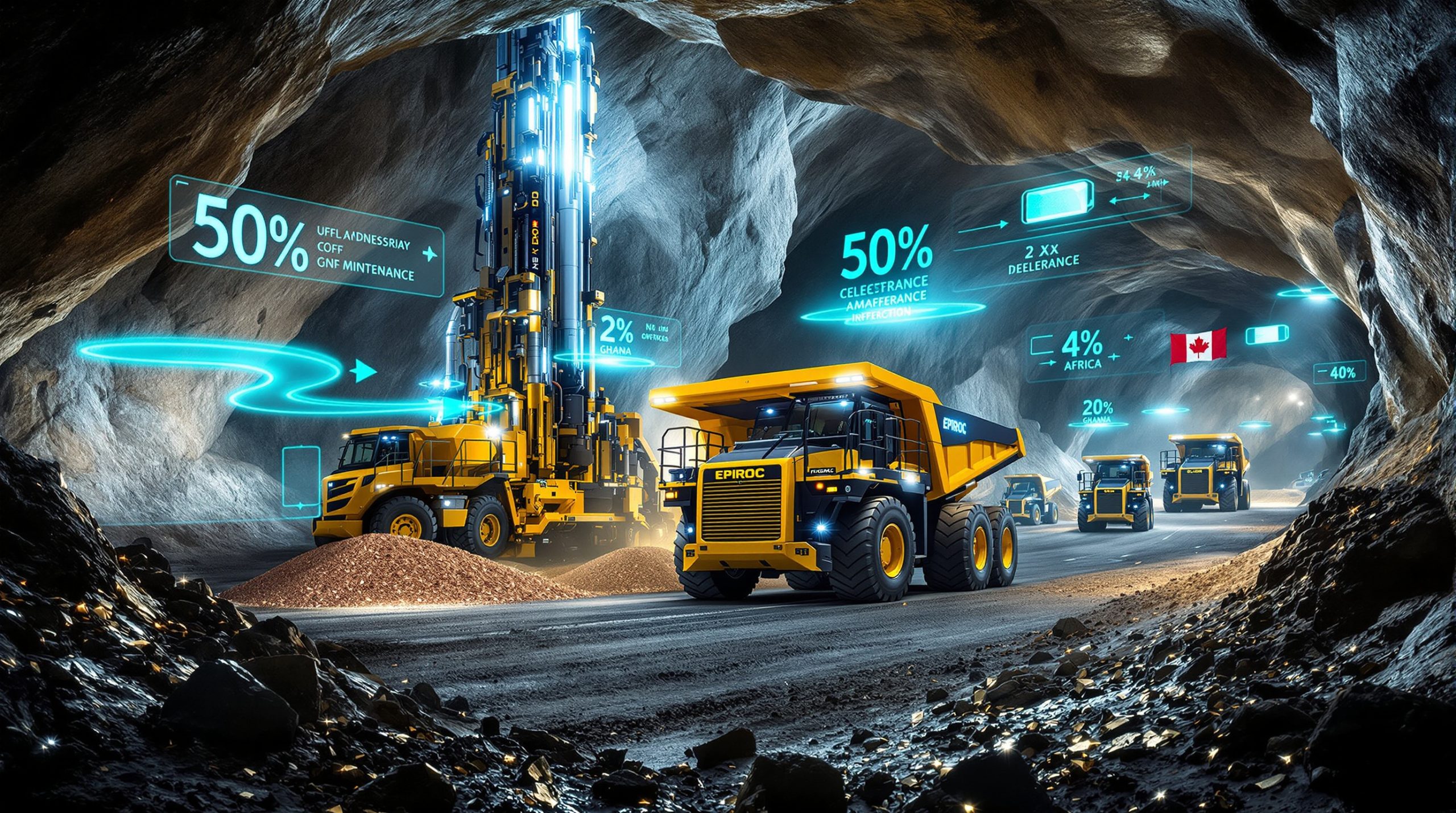What is In-Situ Leaching?
In-situ leaching (ISL) is a mining technique that extracts minerals from ore bodies without excavation, using chemical solutions injected underground to dissolve target minerals. This innovative approach significantly reduces the need for traditional mining infrastructure, such as open pits, tailings ponds, and heavy earthmoving equipment. Instead, ISL operations rely on strategically placed wells to access the minerals within permeable geological formations, significantly reducing the environmental footprint of mining processes. The increasing adoption of in-situ leaching represents mining's crucial and paradoxical role in the clean energy transition, as it offers a less invasive extraction method.
How In-Situ Leaching Works
-
Injection Process: Chemical solutions, known as lixiviants, are pumped into the ground through injection wells positioned in the ore zone. Common lixiviants include sulfuric acid, sodium bicarbonate, or other tailored chemical mixtures optimized for mineral dissolution.
-
Circulation System: The solution migrates through permeable geological formations, contacting and dissolving the target minerals. Geological permeability and carefully managed hydrological containment are crucial to ensuring the effective circulation of solutions.
-
Extraction Method: The mineral-rich fluid (pregnant solution) is pumped to the surface through extraction wells. This extracted fluid often undergoes separation through ion exchange or solvent extraction methods to isolate the desired minerals.
-
Processing: The mineral-laden brine is processed at on-site facilities, extracting valuable minerals and converting them into commercial-grade products.
-
Monitoring: Rigorous environmental monitoring practices, including groundwater monitoring wells, ensure that no contamination occurs and that residual chemicals are safely managed.
What Are the Key Requirements for In-Situ Leaching?
Geological Requirements
-
Rock Permeability: Host rocks must have sufficient permeability (often 1-10 darcy) to allow chemical solutions to flow easily through the ore formation.
-
Mineral Solubility: The target mineral must readily dissolve under specific chemical conditions. Ideal conditions for uranium leaching, for example, occur at certain oxidation potentials (Eh +200mV to +400mV) and pH ranges. Understanding these factors is essential for implementing comprehensive guide to uranium deposits and mining processes.
-
Hydrological Containment: Deposits suitable for ISL must be confined by natural impermeable layers, ensuring solutions and dissolved minerals remain within targeted areas.
-
Mineral Compatibility: Ore deposits should be free of minerals that neutralize chemicals or negatively alter lixiviant effectiveness, such as carbonate-rich minerals that significantly affect acidity levels.
What Are the Environmental Benefits of In-Situ Leaching?
Environmental Advantages
-
No Excavation: ISL completely removes the need to create large open pits or undertake extensive underground excavations, drastically decreasing land disturbance.
-
Reduced Surface Disturbance: The limited infrastructure means a significant reduction—often 85-90%—in the environmental footprint compared to conventional mining.
-
Lower Emissions: ISL processes produce approximately 70% less greenhouse gas emissions by eliminating the need for diesel-powered machinery typically required in excavation processes, aligning with strategies for mining industry decarbonisation.
-
Smaller Footprint: The minimal infrastructure required means smaller operational zones, preserving natural landscapes and biodiversity.
"ISL is often the most cost-effective and environmentally friendly method: a rare win-win for miners and the environment."
What Are the Limitations and Challenges of In-Situ Leaching?
Technical Limitations
-
Limited Application: ISL is uniquely suited only for certain deposit types, predominantly porous sandstone-hosted ores or easily soluble minerals.
-
Chemical Control Challenges: Maintaining chemical balance underground is inherently challenging, as solution behavior and reactions cannot be visually monitored, hence tight hydrological and chemical controls are necessary.
-
Recovery Rates: ISL generally provides lower mineral recovery rates compared to traditional mining processes—between 60% and 90% depending on geological specifics.
Environmental Considerations
-
Waste Management: Processed solutions and waste fluid must be managed and treated, potentially creating complex environmental challenges and considerable disposal requirements.
-
Groundwater Protection: Comprehensive groundwater monitoring is required to prevent contamination, which represents a substantial part of operational expenses. As outlined in CSIRO's research on in-situ recovery techniques, robust monitoring systems are essential.
-
Remediation Requirements: ISL operation remediation can last anywhere from 5 to 15 years, often exceeding the actual production period.
Which Minerals and Deposits Are Suitable for In-Situ Leaching?
Suitable Minerals and Deposits
-
Evaporites:
- Minerals such as salt (halite) and potash (sylvite) dissolve readily, making them highly suitable for ISL extraction.
-
Uranium:
- Approximately 50% of global uranium production utilizes ISL. Sandstone-hosted uranium deposits, such as 'roll front' deposits, are particularly suitable.
-
Copper:
- Copper oxide and carbonate minerals, including malachite, azurite, tenorite, and chrysocolla, are successfully leached using ISL, especially prevalent in historic operations in China.
-
Rare Earth Elements (REE):
- Ion-adsorption clays, notably located in China and Myanmar, represent significant ISL market segments, leveraging tailored ammonium sulfate-based lixiviants.
Unsuitable Minerals
-
Aluminum: This metal resists dissolution significantly, rendering ISL impractical.
-
Primary Sulfide Minerals: These require potent oxidants and highly acidic environments, creating operational and environmental complexity.
-
Gold: Numerous attempts to apply ISL methods in gold extraction have proven unsuccessful to date.
How Does ISL Compare to Conventional Mining Methods?
Operational Advantages
-
Lower Infrastructure Requirements: ISL operations necessitate approximately 60-80% fewer infrastructure costs compared to conventional mining.
-
Reduced Workforce: Operational efficiency and minimal surface management needs reduce labor resource requirements, lowering operational costs further.
-
Improved Safety: Fewer surface operations and automated monitoring systems reduce potential occupational hazards significantly.
-
Faster Development: ISL mines typically transition from development to production quicker, enhancing project economics and investment attractiveness.
Economic Benefits
-
Lower Capital Costs: Economically viable with lower-grade deposits, ISL mines require significantly lower upfront investments, typically ranging from $50-100 million.
-
Reduced Operating Costs: Operational expenses are approximately 30-50% lower compared to conventional mining methods, ensuring profitability even in challenging market conditions.
-
Processing Simplicity: The direct recovery process from mineral-rich fluids significantly streamlines refinement and production steps.
What Is the Inkai Mine Case Study?
The Inkai uranium mine in Kazakhstan exemplifies the viability and effectiveness of ISL:
Inkai Mine Details
-
Location: Kazakhstan
-
Deposit Type: Sandstone-hosted uranium (roll front style)
-
Depth: Approximately 250 meters
-
Reserves: 344 million tonnes grading 0.04% U₃O₈
-
Production: Up to 10.4 million pounds U₃O₈ per year
-
Recovery Rate: Around 85%
-
Production Cost: Less than $10 per pound
-
Ownership: 60% Kazatomprom, 40% Cameco
-
Operational Period: 2009 – projected to 2045
What Is the Future of In-Situ Leaching?
Future Developments
-
Expanding Applications: Advanced research aims to broaden ISL applicability beyond uranium and specialty minerals.
-
Improved Solutions: Development of environmentally friendlier, biodegradable lixiviants is gaining traction in R&D agendas globally.
-
Enhanced Recovery: Nanotechnology and optimized fluid chemistry are set to achieve increased recovery rates.
-
Better Monitoring: Deployment of real-time underground monitoring systems utilizing cutting-edge sensors promises major improvements in control and efficiency. Moreover, innovative digital transformation in mining is driving significant advancements in monitoring technology.
-
Reduced Environmental Impact: Continuous improvements in post-leach remediation strategies significantly decrease environmental risks, addressing ESG challenges and opportunities in the mining industry.
What Are the Economic Implications of In-Situ Leaching?
Economic Impacts
-
Low-Grade Viability: ISL can make low-grade mineral deposits economically attractive, thus expanding mining opportunities.
-
Lower Capital Requirements: Lower barriers of entry allow smaller investors into the mining industry, diversifying market participation.
-
Operating Cost Advantages: Reduced operational expenses can sustain ISL operations even during commodity price downturns.
-
Extended Mine Life: ISL techniques can prolong profits by operating economically on previously mined-out deposits.
FAQ About In-Situ Leaching
Is In-Situ Leaching Safe for the Environment?
Yes, ISL is generally more environmentally friendly; however, it requires extensive monitoring and management practices to safeguard groundwater resources. According to Geology for Investors, when properly managed, it represents a cleaner approach to mineral extraction.
Can In-Situ Leaching Replace Conventional Mining?
No, ISL is suitable only for certain deposit types with specific geological, chemical, and hydrological conditions. Conventional mining will continue to be critical for most mineral extraction globally.
Interested in Identifying the Next Investment Opportunity in Innovative Mining Methods?
For real-time alerts on companies pioneering in-situ leaching and other breakthrough mining technologies, explore Discovery Alert's proprietary Discovery IQ model at discoveryalert.com.au/discoveries/ and position yourself ahead of the market with actionable insights on ASX mineral discoveries.




